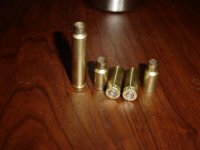J
jpipes
Guest
All -
I experienced my first case separation today while fireforming brass for my new 223ai. I was told that it's probably not headspace issues, just that the load (55 gr FMJ, behind 26 gr of varget, in virgin winchester brass) might have jumped too far and simulated headspacing issues.
To that point, the fireforming loads with 75 gr amax, loaded as close to the lands as I could get while still feeding from the mag box, turned out fine. There is a slight "ring" in the same place that the other loads broke the case in two.
Attached are pictures of the split cases, along with a piece of brass loaded with the amax bullets.
The rifle specs are as follows: shilen 8 twist in 22inches, fully blueprinted 700 action.
Thoughts?
Best,
Josh
I experienced my first case separation today while fireforming brass for my new 223ai. I was told that it's probably not headspace issues, just that the load (55 gr FMJ, behind 26 gr of varget, in virgin winchester brass) might have jumped too far and simulated headspacing issues.
To that point, the fireforming loads with 75 gr amax, loaded as close to the lands as I could get while still feeding from the mag box, turned out fine. There is a slight "ring" in the same place that the other loads broke the case in two.
Attached are pictures of the split cases, along with a piece of brass loaded with the amax bullets.
The rifle specs are as follows: shilen 8 twist in 22inches, fully blueprinted 700 action.
Thoughts?
Best,
Josh


